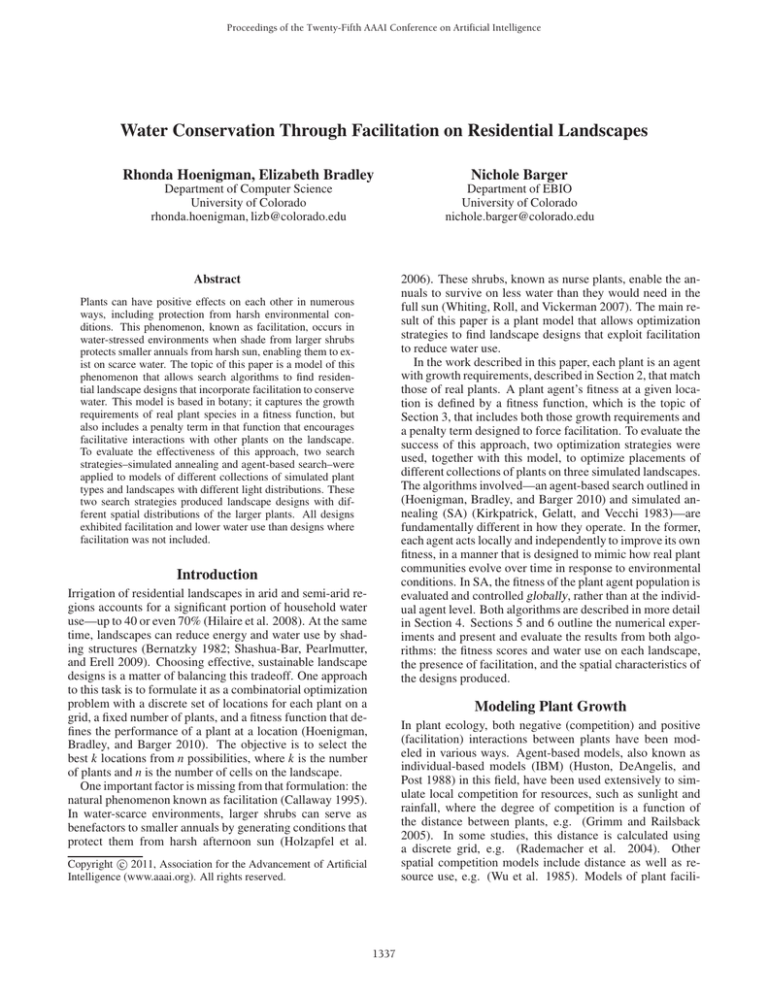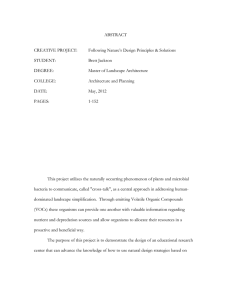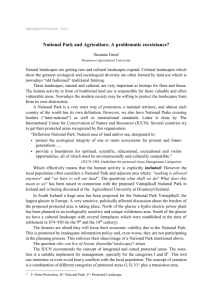
Proceedings of the Twenty-Fifth AAAI Conference on Artificial Intelligence
Water Conservation Through Facilitation on Residential Landscapes
Rhonda Hoenigman, Elizabeth Bradley
Nichole Barger
Department of Computer Science
University of Colorado
rhonda.hoenigman, lizb@colorado.edu
Department of EBIO
University of Colorado
nichole.barger@colorado.edu
2006). These shrubs, known as nurse plants, enable the annuals to survive on less water than they would need in the
full sun (Whiting, Roll, and Vickerman 2007). The main result of this paper is a plant model that allows optimization
strategies to find landscape designs that exploit facilitation
to reduce water use.
In the work described in this paper, each plant is an agent
with growth requirements, described in Section 2, that match
those of real plants. A plant agent’s fitness at a given location is defined by a fitness function, which is the topic of
Section 3, that includes both those growth requirements and
a penalty term designed to force facilitation. To evaluate the
success of this approach, two optimization strategies were
used, together with this model, to optimize placements of
different collections of plants on three simulated landscapes.
The algorithms involved—an agent-based search outlined in
(Hoenigman, Bradley, and Barger 2010) and simulated annealing (SA) (Kirkpatrick, Gelatt, and Vecchi 1983)—are
fundamentally different in how they operate. In the former,
each agent acts locally and independently to improve its own
fitness, in a manner that is designed to mimic how real plant
communities evolve over time in response to environmental
conditions. In SA, the fitness of the plant agent population is
evaluated and controlled globally, rather than at the individual agent level. Both algorithms are described in more detail
in Section 4. Sections 5 and 6 outline the numerical experiments and present and evaluate the results from both algorithms: the fitness scores and water use on each landscape,
the presence of facilitation, and the spatial characteristics of
the designs produced.
Abstract
Plants can have positive effects on each other in numerous
ways, including protection from harsh environmental conditions. This phenomenon, known as facilitation, occurs in
water-stressed environments when shade from larger shrubs
protects smaller annuals from harsh sun, enabling them to exist on scarce water. The topic of this paper is a model of this
phenomenon that allows search algorithms to find residential landscape designs that incorporate facilitation to conserve
water. This model is based in botany; it captures the growth
requirements of real plant species in a fitness function, but
also includes a penalty term in that function that encourages
facilitative interactions with other plants on the landscape.
To evaluate the effectiveness of this approach, two search
strategies–simulated annealing and agent-based search–were
applied to models of different collections of simulated plant
types and landscapes with different light distributions. These
two search strategies produced landscape designs with different spatial distributions of the larger plants. All designs
exhibited facilitation and lower water use than designs where
facilitation was not included.
Introduction
Irrigation of residential landscapes in arid and semi-arid regions accounts for a significant portion of household water
use—up to 40 or even 70% (Hilaire et al. 2008). At the same
time, landscapes can reduce energy and water use by shading structures (Bernatzky 1982; Shashua-Bar, Pearlmutter,
and Erell 2009). Choosing effective, sustainable landscape
designs is a matter of balancing this tradeoff. One approach
to this task is to formulate it as a combinatorial optimization
problem with a discrete set of locations for each plant on a
grid, a fixed number of plants, and a fitness function that defines the performance of a plant at a location (Hoenigman,
Bradley, and Barger 2010). The objective is to select the
best k locations from n possibilities, where k is the number
of plants and n is the number of cells on the landscape.
One important factor is missing from that formulation: the
natural phenomenon known as facilitation (Callaway 1995).
In water-scarce environments, larger shrubs can serve as
benefactors to smaller annuals by generating conditions that
protect them from harsh afternoon sun (Holzapfel et al.
Modeling Plant Growth
In plant ecology, both negative (competition) and positive
(facilitation) interactions between plants have been modeled in various ways. Agent-based models, also known as
individual-based models (IBM) (Huston, DeAngelis, and
Post 1988) in this field, have been used extensively to simulate local competition for resources, such as sunlight and
rainfall, where the degree of competition is a function of
the distance between plants, e.g. (Grimm and Railsback
2005). In some studies, this distance is calculated using
a discrete grid, e.g. (Rademacher et al. 2004). Other
spatial competition models include distance as well as resource use, e.g. (Wu et al. 1985). Models of plant facili-
c 2011, Association for the Advancement of Artificial
Copyright Intelligence (www.aaai.org). All rights reserved.
1337
tation are less common, but have been used to show interactions in many types of ecosystems, including alpine environments (Callaway et al. 2002), and between shrubs and
annuals along an aridity gradient (Holzapfel et al. 2006;
Tielborger and Kadmon 2000).
On residential landscapes, both competition and facilitation play important roles due to heterogeneity in the types of
plants and in the landscape conditions. There are, however,
few examples in the currently available ecological models that are able to capture both types of interactions, e.g.
(Holmgren, Scheffer, and Huston 1997). Effective analysis
and optimization of residential landscapes involves modeling both individual plant performance and the effects of both
competition and facilitation. To accomplish this, the approach used here represents resources and conditions explicitly in each cell on the simulated landscape—an approach
that is simpler and more natural than the currently available
ecological models. Using this approach, the growth rates of
a heterogeneous set of individuals emerge directly from the
resources available to each individual at its location.
Plants need light, water, and nutrients to grow. As they do
so, they influence their surroundings primarily by removing water from the landscape and generating shade. The
plant-growth model used here includes these basic features,
with one exception: nutrients are not considered as these
can be modified on built landscapes. This growth model,
which is described in more detail in (Hoenigman, Bradley,
and Barger 2010), is based on empirical data for how real
plants respond to different levels of light and water availability (Harvey 1979). In it, each plant is represented as an
agent whose growth is determined by the amount of light
and water available at its location on the landscape. Plant
growth is nonlinear: it increases with increasing light, up to
a certain point, known as the light saturation point (Crawley
1997). Above this level, additional light does not result in
additional growth and can actually decrease growth due to
other processes necessary for plant survival. The amount of
water that a plant requires—the other key factor in the model
proposed here—is based on its growth rate, size, water-use
category, and light level. Light and water effects are not independent; high growth rates and larger sizes require more
water, for instance, and plants need more water in full sun
than in partial sun because they use it to stay cool (Gardingen and Grace 1991).
Plant agents in this work are classified into discrete categories, similar to those used to categorize real nursery
plants: three levels of light requirements—low, medium, and
high—and two levels of water requirements (low and high).
This results in six types of plants. The landscape conditions
in which these plant agents grow are represented using a discrete grid, where each cell in the grid is one square foot.
This size is the average space needed by summer annuals,
the smallest plants considered here. Only one plant can occupy a cell at each time step. Each landscape cell has three
parameters: morning light, afternoon light, and water, representing the amount of that resource present in the cell at a
given time. Considering morning and afternoon light separately is critical to modeling facilitation, since the effects of
nurse plants come into play in the strong afternoon sun.
Plant agents interact with the landscape—and, indirectly,
with each other—in two ways: by removing water from their
own and surrounding cells and by generating shade. Both of
these effects occur in proportion to their size. Plant agents
one foot or shorter can only use water from their own cell;
those taller than one foot can access water in surrounding
cells proportional to their size over one foot. The water that
a plant agent needs to grow is withdrawn evenly from all
cells that it can access. This is an approximation of water
use in real plants—larger plants have larger root structures
and an increased reach for water. Light effects are similar
and also include directionality. Plant agents generate shade
in surrounding cells, again in proportion to their size. Each
foot of height over one foot shades one cell in the horizontal direction; for each two feet of height over one foot, the
plant also shades one cell in the vertical direction. Cells to
the right of the plant agent (east) are shaded in the afternoon
and cells to the left (west) are shaded in the morning. If a
cell is shaded, the light in that cell is reduced by 30%. If two
plants shade the same cell, the shade effects are multiplicative, the 30% reduction is applied twice, once to the original
value, and then again to the reduced value. This profile does
not entirely reflect real-world shading, as cells south of the
plant should never be shaded (in the northern hemisphere);
these effects will be addressed in future work. This model
only includes the mid-summer sun angle because the primary concern here is reducing water use, which is highest in
the summer.
Plant Agent Fitness
The fitness score measures plant growth and water use in
different light and water conditions. It includes a growth
portion that is based on the plant agent’s biological properties and an additional penalty for high-water-use conditions.
The plant-growth model and the landscape conditions determine the biological portion of the score. The penalty term
is engineered to encourage facilitation; it is a function of the
available light and the agent’s size and light saturation point.
The fitness for an arrangement of plant agents is the sum of
the fitness for each individual agent. The dynamics of irrigation require that the fitness be calculated over a multi-day
period: a plant with high water requirements or exposure to
harsh sun may not have enough water to survive between
irrigation cycles in an arid or semi-arid region. The fitness
calculation proceeds as follows:
• Step 1—Calculate morning fitness using the agent’s light
response curve, the water needed to support this growth,
and the available light and water using the equation
mGrowth =
mBiomass ∗ wAvailable
wN eeded
maxM Biomass
(1)
where mBiomass is the expected biomass given the plant
agent’s morning light, wN eeded is the amount of water
needed to support growth at this light level, wAvailable
is the amount of water the agent can extract from the soil
to support growth, and maxM Biomass is the expected
biomass under optimal light conditions.
1338
• Step 2—Calculate the amount of water used by each plant
agent during the morning period and update the landscape
conditions accordingly. See (Hoenigman, Bradley, and
Barger 2010) for more detail.
• Step 3—Calculate afternoon fitness using same variables
as in the morning fitness calculation and the equation
Search Algorithms
Calculating the optimal solution in combinatorial problems
is computationally prohibitive for anything but the simplest
situations. As a result, metaheuristics, such as simulated annealing (SA) and genetic algorithms, are often used to search
for good solutions (Alp and Erkut 2003; Otto and Kokai
2008). An objective function measures the global fitness for
a solution; the search process identifies solutions that improve the global fitness. A very different type of metaheuristic relies on the notion of autonomous agents that act independently to improve their own individual fitness. In these
schemes, the global fitness “emerges” from the individual
actions and interactions (Arentz and Timmermans 2007;
Moujahed, Simonin, and Koukam 2009).
In the landscaping problem presented in this paper, the
objective is to select the best k out of n total cells on a
landscape, where k is the number of plants. There are no
repetitions of the k elements on the landscape, and assigning a plant to a cell effectively generates an ordering that is
meaningful to the solution. This process is a k-permutation
n!
possible permutations. The two search
of n with (n−k)!
algorithms evaluated in this paper—simulated annealing, a
global control search routine, and an agent-based search
routine—were selected to represent different search methodologies used for combinatorial problems. Both algorithms
use the plant-growth model and fitness function described
above to define the behavior of the individual plant agents.
The main difference between the two algorithms is in how
individual moves are evaluated. In SA, a random location
is selected for each plant agent. If that new location improves the global fitness score, the agent moves to that location. If the new location does not improve the global fitness, the agent still moves—with a probability that decreases
as the search progresses. These non-improving moves are
designed to keep the algorithm from getting stuck in local optima. The search stops when the probability of nonimproving moves reaches zero and there are no moves that
improve fitness. An outline of the SA search routine used
here is shown in Algorithm 1. In the agent-based search algorithm, plant agents employ a combination of local search
and random jumps to improve their own individual fitness
scores—without concern for global fitness. Agents have a
fixed number of times that they can move during the search
process; which guarantees that the algorithm will converge
to a solution and models the physical reality of the effects of
re-planting. Agents first search locally within a pre-defined
search radius that designed to allow agents to move out of
the influence zone of other agents. An increasing threshold
score controls the search process—agents move if their score
is below this threshold. This value is initially set low and
increased as agents find better conditions on the landscape,
which is reflected in higher fitness scores. The search stops
when fitness scores can no longer be improved above this
threshold and agents have used up their allowable moves.
An outline of the algorithm is shown in Algorithm 2; additional details about the algorithm can be found in (Hoenigman, Bradley, and Barger 2010).
aBiomass ∗ wAvailable
wN eeded
(2)
maxABiomass
• Step 4—Calculate the amount of water used by each plant
agent during the afternoon period and update the landscape conditions accordingly.
• Step 5—Calculate the agent’s daily fitness score from the
morning and afternoon fitness scores.
dayGrowth = mGrowth + aGrowth
(3)
aGrowth =
• Step 6—Calculate the penalty value for light conditions
beyond the plant agent’s light saturation point.
mL + aL − 2 ∗ lS
) (4)
penalty = α ∗ (maxH − h) ∗ (
2 ∗ lS
where mL is morning light, aL is afternoon light, α is a
user-defined weight parameter, maxH is a user-defined
height that controls how the penalty affects differentsized plants, h is the size of the plant, and lS is the
plant-specific light saturation point. The α parameter
adjusts how much the penalty contributes to the total
fitness score. The maxH parameter controls how the
penalty affects plant agents of different sizes, which is
a key element of the fitness function. The penalty term
is designed to encourage facilitation by allowing larger
nurse plants to be located in full sun to provide shade for
smaller plants. Without the maxH parameters, the nurse
plants would have low fitness scores in full-sun conditions, which would not achieve the objectives of the model
or reflect observed behavior on real landscapes (Holzapfel
et al. 2006). When the plant agent’s height, h, is equal to
maxH, the penalty is zero. The penalty increases with
decreasing plant height. The penalty also increases with
increasing light above lS.
• Step 7—Calculate final daily fitness score including
growth and penalty components
dayF it = dayGrowth − penalty
(5)
• Step 8—Repeat Steps 1-7 for user-defined number of
days to calculate agent’s final multi-day fitness score
days
dayF itd
(6)
agentF itness = d=1
days
where d is the day number, and days is the total number of
days being simulated. The growth score has a maximum
value of one, and the penalty term can only reduce the
final fitness score.
• Step 9—Calculate fitness score for the arrangement
n
landscapeF itness =
agentF itnessi
(7)
i=1
where n is the number of plants.
1339
Algorithm 1 Simulated annealing
1: Set starting temperature to 0.9
2: Generate land //random locations for all plant agents
3: Calculate fland //fitness score for landscape
4: repeat
5:
for all agents do
6:
Select new random location for plant agent
7:
Calculate fland //new fitness score
8:
if fland > fland then
9:
land = land
10:
else
11:
Move with uniform probability, pr(move) <
heat
12:
end if
13:
end for
14:
heat = heat - 0.01
15: until heat = 0
Algorithm 2 Agent-based search
1: repeat
2:
for all agents do
3:
Calculate fitness score for plant agent.
4:
if score > threshold then
5:
Leave the plant alone
6:
else
7:
if plant moves < moves allowed then
8:
Search locally for better location
9:
if local search successful then
10:
if location unoccupied then
11:
Plant agent relocates to new location.
12:
else
13:
Plant agents compete. Loser gets new
random location.
14:
end if
15:
else
16:
Plant agent moves to random unoccupied
location.
17:
end if
18:
Increment plant moves
19:
end if
20:
end if
21:
end for
22: until scores > threshold for all plants or no more moves
allowed
23: If a solution is found for all plants above the threshold,
increase threshold and repeat the algorithm.
Numerical Experiments
In order to evaluate the utility of the model proposed here,
a series of experiments was performed using both search
strategies to place different collections of plants on three
simulated landscapes:
• Scenario 1—The landscape size is 25x25 cells, all of
which receive full morning and afternoon sun. A collection of 46 plants is to be placed on this landscape, including six, six-foot nurse plants that require full sun and low
water. All of the shade created on this landscape will be
due to the placement of these nurse plants. The other 40
plants, which represent smaller annuals, have similar requirements and a height of one foot.
The parameters for each algorithm, which include the
number of moves allowed and the local search neighborhood
for the agent search and the cooling speed for SA, were selected by running the algorithms for a range of these parameters and selecting the parameters that generated the highest
fitness scores. For the agent search, agents were allowed
to move 10 times and search five cells locally. For SA, a
cooling parameter of 0.01 was used. In each scenario, the
agent-based search routine was applied from 20 initial conditions and SA was applied from 30 initial conditions, where
an initial condition is a random location for each plant agent.
This number of initial conditions for each algorithm generated comparable computational efforts and, therefore, provides a good comparison. Each search routine was repeated
100 times, resulting in 100 solutions to evaluate for each scenario. The results reported in this paper are the mean results
from these 100 runs for each scenario. The water use for
100 randomly placed configurations for each scenario was
used for comparison to the agent-based and SA solutions. In
these random configurations, no optimization strategy was
used to encourage facilitation on the landscape.
• Scenario 2—The plants are the same as in Scenario 1,
but the landscape is 25x30 and 50% of its area is modeled
with existing afternoon shade (e.g., from buildings on two
sides). The purpose of this scenario is to examine how the
presence of existing shade affects both the smaller plants
and the nurse plants.
• Scenario 3–This scenario uses the same landscape conditions as in Scenario 2, but includes a more-diverse plant
collection: 10 full-sun, low-water nurse plants; 10 1-foot
full-sun, low-water plants; 10 2-foot full-sun, high-water
plants; 10 1-foot shade-loving, high-water plants; and 10
1.5-foot partial-sun, high-water plants. This scenario is
designed to test the effect of facilitation on a realistically
diverse group of plants with higher water requirements.
These experiments represent conditions observed on real
landscapes in terms of the types of plants, variability in lighting, and plant density. The search algorithms were evaluated
by calculating the fitness scores, water use, role of facilitation, and spatial characteristics of the final solutions in each
case. The water use was also compared to that of a random
placement of each plant collection on each landscape. The
water on the landscapes was initialized to represent recently
irrigated soils in many areas in the U.S. Southwest. Plant
agents grew for five days.
Results
The results from both search algorithms show facilitation in
all three scenarios. The average fitness scores for all 100
solutions in each scenario were within 15% percent of each
other, with the SA scores consistently higher than the agent
search scores. Figure 1 shows a visual example on one lay-
1340
Figure 1: Example SA solution for Scenario 1. In this example, all but one of the smaller annuals (shown in blue) ended
up in protected conditions generated by the nurse plants.
out produced by SA for Scenario 1. The nurse plants are the
red triangles and the small annuals are the blue stars. The
number next to each plant is the plant’s fitness score at that
location. The shaded regions show the afternoon shade generated by the nurse plants; the lighter areas represent full
sun. In this solution, only one plant ended up in unprotected
conditions—the one with the lower fitness score at the top
left of the image. The higher scores for the shaded annuals
reflect the improved growing conditions created by facilitation, in the form of afternoon shade. This pattern is generic
across all three scenarios for both algorithms. In Scenario 1,
for example, 93% of the small annuals in the agent solutions
and 97% of small annuals in the SA solutions benefit from
facilitation.
The spatial configuration effects created by facilitation
greatly reduced water use on these landscapes. In Scenario
1, for instance, the average small annual in the agent-based
design uses 0.98 gallons over the five-day simulation, as
compared to 0.87 gallons in the design produced by SA.
In all three scenarios, water use in the random placements
is higher than in the SA or agent solutions—about 5-10%
higher in Scenario 1, for example. In Scenario 3, this difference is even more dramatic, underscoring the potential for
facilitation-based water savings. Here, the randomly placed
plants use an average of 3 gallons over the five-day simulation, while the agent and SA-placed plants use 1.9 gallons
and 1.74 gallons respectively—a savings of 37 and 42%.
There are some interesting differences between the SA
and agent-based solutions, primarily in the spatial distribution of the plants and the nurse plants’ effect on the landscape. Figure 2 shows an example of these spatial distributions for both algorithms for Scenario 2. In both solutions,
all small annuals are in protected conditions and most nurse
plants are in full sun. The nurse plants’ contributions to facilitation are different in the solutions produced by the two
algorithms, however. In the SA solution, the nurse plants
have very few neighbors—i.e., most of the smaller annuals
are placed in the existing shade. In contrast, many of the
smaller annuals in the agent solution are placed in the nurse
plants’ shade. While facilitation is at work in both solutions,
its characteristics are different. This pattern is particularly
pronounced in Scenario 2, where 61% (standard deviation
Figure 2: Example optimized plant placements produced by
agent search (top) and SA (bottom) for Scenario 2. Smaller
annuals were more likely to cluster around the nurse plants
in the former than in the latter.
11%) of small annuals in the agent solutions are in protected
conditions generated by the nurse plants, as compared to
only 35% (standard deviation 10%) in the SA solutions.
Another difference in spatial distribution manifests in the
placement of the nurse plants in relation to the shade on the
landscape. This difference can be seen in Figure 3, which
shows example solutions for Scenario 3. In these solutions,
many more nurse plants are located in the existing shade
in the SA solution than in the agent solution, where nurse
plants tend to cluster in the full sun. This pattern is generic;
in Scenario 3, for example, 31% (standard deviation 14%) of
nurse plants are in the full-sun region in the agent solutions
as compared to only 15% (standard deviation 12%) in the
SA solutions.
While these spatial patterns enhance water savings, they
have some limitations. The existing shade on the landscape
produced higher fitness scores than the shade from the nurse
plants, as it generated light conditions closer to the agents’
light saturation points. An effective search algorithm could
find these higher fitness scores. The smaller plants clustered
near the nurse plants could indicate, for example, that they
found acceptable conditions during the local search portion
of the algorithm but did not have enough optimization pressure to continue searching for better conditions. On the other
hand, this is the nature of an agent-based search algorithm,
which is a natural match to the problem at hand. Recall
that the objective here is to design landscapes that use facilitation to improve growing conditions while also reducing
water use. By presenting design patterns with plants consistently placed in the same region on the landscape, SA may
1341
Callaway, R., et al. 2002. Positive interactions among alpine
plants increase with stress. Nature 417:844–848.
Callaway, R. 1995. Positive interactions among plants. The
Botanical Review 61:306–349.
Crawley, M., ed. 1997. Plant Ecology. Oxford: Blackwell
Scientific Publications.
Gardingen, P. V., and Grace, J. 1991. Plants and wind.
Advances in Botanical Research 18:192–254.
Grimm, V., and Railsback, S. 2005. Individual-based Modeling and Ecology. Princeton, New Jersey: Princeton University Press.
Harvey, G. 1979. Photosynthetic performance of isolated
leaf cells from sun and shade plants. Carnegie Inst. Washington Yearbook 79:161–164.
Hilaire, R. S., et al. 2008. Efficient water use in residential
urban landscapes. HortScience 43(7):2081–2092.
Hoenigman, R.; Bradley, E.; and Barger, N. 2010.
Agentscapes–Designing water efficient landscapes using
distributed agent-based optimization. Proceedings of the
12th Annual Conference Companion on Genetic and Evolutionary Computation Conference: Late Breaking Papers
1777–1784.
Holmgren, M.; Scheffer, M.; and Huston, M. 1997. The interplay of facilitation and competition in plant communities.
Ecology 78:1966–1975.
Holzapfel, C., et al. 2006. Annual plant-shrub interactions
along an aridity gradient. Basic Appl. Ecol. 7:268–279.
Huston, M.; DeAngelis, D.; and Post, W. 1988. New
computer models unify ecological theory. BioScience
38(10):682–691.
Kirkpatrick, S.; Gelatt, C.; and Vecchi, M. 1983. Optimization by simulated annealing. Science. New Series
220(4598):671–680.
Moujahed, S.; Simonin, O.; and Koukam, A. 2009. Location problems optimization by a self-organizing multiagent
approach. Multiagent and Grid Systems 5(1):59–74.
Otto, S., and Kokai, G. 2008. Decentralized evolutionary optimization approach to the p-median problem. LNCS
4974:659–668.
Rademacher, C., et al. 2004. Reconstructing spatiotemporal dynamics of central European beech forests: The rulebased model BEFORE. Forest Ecology and Management
194:349–368.
Shashua-Bar, L.; Pearlmutter, D.; and Erell, E. 2009. The
cooling efficiency of urban landscape strategies in a hot dry
climate. Landscape and Urban Planning 92:179–186.
Tielborger, K., and Kadmon, R. 2000. Temporal environmental variation tips the balance between facilitation and interference in desert plants. Ecology 81:1544–1553.
Whiting, D.; Roll, M.; and Vickerman, L. 2007. Plant
Growth Factors: Light – Garden Notes 142. Colorado State
University Cooperative Extension.
Wu, H.-I., et al. 1985. Ecological field theory: A spatial
analysis of resource interference among plants. Ecological
Modelling 29:215–243.
Figure 3: Example optimized plant placements produced by
agent search (top) and SA (bottom) for Scenario 3. The
nurse plants tended to cluster in the full sun in the agentbased solution and in the shade in the SA solution.
not be an appropriate algorithm for this problem. This is particularly true if aesthetics and subjective human choice are
involved in the process. While SA produced higher average
fitness scores, the agent-based search algorithm generated
more space on the landscape with good growing conditions.
Conclusion
This computational model for optimizing landscapes represents a new approach for water conservation in residential
systems. The results show that optimization strategies that
take facilitation into account can generate significant water
savings, particularly on heterogeneous landscapes containing high-water plants, which are common residential landscape design elements—even in water-scarce regions. The
results presented here are based on a growth model generated from empirical data from real plants. The next stage
in this work will involve experimenting with real plants in
order to tune the plant-growth model (i.e., the relationship
between light, water, and growth in landscaping plants, and
the effects of plant interactions) and to validate the role of
facilitation in water conservation on residential landscapes.
References
Alp, O., and Erkut, E. 2003. An efficient genetic algorithm
for the p-median problem. Ann Oper Res 122:21–42.
Arentz, T., and Timmermans, H. 2007. A multi-agent
activity-based model of facility location choice and use. disP
170(3):33–44.
Bernatzky, A. 1982. The contribution of trees and green
spaces to a town climate. Energy Build. 5:1–10.
1342









